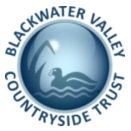A chance to explore the more rural paths and country lanes in the Valley. This walk passes the confluence of the Blackwater and Whitewater rivers where they become the River Broadwater, before joining the River Loddon further upstream.
About the walk
Start point: Swallowfield Parish car park, Church Road, Swallowfield. SU 726649
Distance: 9.5 km/ 6 miles
Walk time: 3 hours
Terrain: Relatively flat with slopes, uneven ground and stiles. Can be wet and muddy in winter.
Getting there
Rail to Trail: there is no train station nearby. The number 7 bus stops at the Crown Public House from where there is a half mile walk to the start point. Walk north east from the Crown towards Curly’s Way. At the roundabout take the first exit onto Church Road The church is 0.4 mile along this road.
Swallowfield Park
- 1. Exit the car park onto Church Road and turn left. Continue along the road past Swallowfield Park taking care when the pavement runs out and when crossing two bridges over the river.
- 2. After the entrance to All Saints Church, there is a bend in the road to the right. Just after this bend on the left cross over a stile and follow the signed footpath along a field edge. Continue past a path junction and then pass through a gate on the left, to continue along a hedge line on the other side. Follow a tree-lined track straight on, to join Swallowfield Road.
- 3. Cross the road with care and turn left. Continue along the road until a footpath on the right, just after 'Old Dunnings', on the left. Follow the footpath uphill into Great Copse. Carry straight on past houses, where the track becomes hardstanding.
Farley Hill
- 4. At the crossroads go straight over to join Bunces Shaw. Continue until a signed footpath on the right, just after Castle Cottage. This path leads through a wooded strip alongside a riding stables and cricket club grounds.
- 5. Turn right onto Church Lane and then left into Castle Road. Follow the road to Bunglers Hill. Taking care, cross to the far side and turn left. Continue along the pavement past a school and The Fox and Hound Pub.
- 6. Just after the pub turn right down Jouldings Lane. Follow the lane downhill. Where the Lane bends to the Part of the countryside landscape seen on the walk right take the signed footpath on the left. This path emerges onto the Blackwater Valley Path. Turn right to go through a gate. Keep the fence close on your left until Jouldings Lane.
Along the River Blackwater
- 7. Cross straight over the lane and enter a field, via a stile, to continue along the footpath. Follow the Blackwater Valley Path to the left of the field along the river bank. The Path leaves the river's edge and heads along field edges, before emerging at Thatcher's Ford. Cross Ford Lane and proceed over a stile into the next field. Continue along the edge of the field and do not cross at the bridge.
- 8. Pass the confluence, of the Rivers Blackwater and Whitewater. Follow the Path right as it leaves the riverbank and head towards Nutbean Lane. Turn left onto the lane and continue past the cemetery to the main road.
- 9. Turn left onto Swallowfield Road, crossing the bridge after All Saints Church. Take care where there is no pavement. Continue past Swallowfield Park and into the village, then back to Swallowfield Parish Hall car park on the right.
